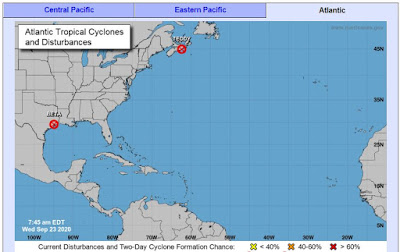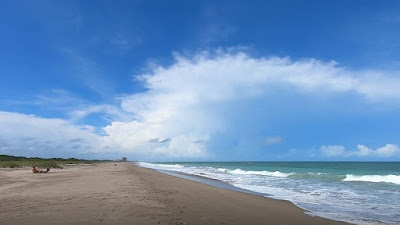Written by the TreasureGuide for the exclusive use of the Treasure Beaches Report.
Dunes North of Turtle Trail Tuesday.
A few people were hunting the base of the dunes Tuesday. The water had hit the dunes and caused a little erosion. The erosion did not get to the old sand in most places. The most obvious sign in the photo above is the clumps of sea oats that was planted after one of the renourishment projects.
Even in some areas where it appeared that the dunes had eroded back to the old sand, it hadn't. You could see, especially behind some of the posts for older steps, where the sand had been back much farther in the past and then was filled again, in some cases more than once.
I didn't see any dunes that were eroded back to the dunes that would hold 1715 Fleet artifacts. Perhaps I would have if I walked far enough. Remember, these dunes were cut many times in the past, such as during the 1984 Thanksgiving Storm. It didn't appear to me that the dunes were back to those levels any place that I saw.
---
You might remember the beach conditions rating scale that I developed and used over the years. Lately I haven't been using it much because this summer conditions have been so consistently poor and I got tired of posting the same old "1" rating. In fact I almost forgot about the rating scale, but I've been getting some email questions about beach conditions, and I think I need to start posting the ratings again, but maybe in a different way.
First, I'd rate current beach detecting conditions as transitional, but I should remind you how the rating scale works.
A rating of "1" indicates poor conditions, "2" transitional conditions, "3" good conditions, "4" very good, and "5" excellent conditions.
The rating is for detecting treasure coins on the Treasure Coast treasure beaches. It does not include Jupiter or Melborne. It is mostly for the 1715 Fleet beaches. I don't get to Melborne or Jupiter enough to include them anyhow.
Poor conditions are defined as virtually no cuts or erosion, with building beaches and mushy sand extending out into the water. When I say virtually no cuts or erosion, there can be very small, or superficial cuts to some small areas. The lowest rating on my scale is a 1 rather than a zero because there is always some chance, even if it is very remote.
A "2" rating indicates what I am now calling "transitional" conditions. There can be scattered cuts or erosion mostly confined to the front beach areas, usually three feet or less and only found on some of the beaches,. It can also include times when there are no cuts but when the sand is reduced in depth enough to slightly improved chances of a treasure coin being found. There would be some stirring of sand and conditions could improve quickly with minor changes to the wind or waves. There is also the possibility of finds in areas that show less obvious signs of improvement such a subtle change to the slope of the beach.
A "3" rating indicates extensive three foot or greater cuts cutting back into the middle beach area either on several beaches or very extensively on one of the primary treasure beaches.
Very good conditions and a "4" rating indicates three foot or greater cuts moving far back into the middle beach often with some water hitting the back dunes and possibly some slight erosion of the back beach or dune areas in a few areas.
Excellent conditions and a "5" rating indicates extensive movement of sand from the front beach and middle beach with significant erosion of the back beach and dunes on several treasure beaches.
With improving conditions, the chances of recovering shipwreck treasure coins is increased. At one time I gave a probability rating of treasure coins being found corresponding to each of the 5 ratings. That is another way of doing it, but I feel more comfortable defining the ratings in terms of observable beach conditions. A higher rating also suggests an increased probability of finds.
Perhaps this chart will help.
As beach conditions improve the number of finds will increase. As the chart suggests, the vast number of finds are made during excellent conditions, and fewer, but still a lot during very good conditions. History proves that out.
Below is what I said in a 2017 post. (https://treasurebeachesreport.blogspot.com/2017/04/41517-report-huge-importance-of-beach.html)
Finding old shipwreck treasure coins on the beach is a different type of hunting. The vast majority of coins are found on a very few special days. Those days are rare. They don't occur every year. They might only occur once every several years. They are special times like during the Thanksgiving storm of 1984 or after hurricanes Francis and Jeanne. Numerous finds are made during especially productive times like that. During times like that people can find more treasure coins in a few days than they might otherwise find during a entire year or more.
I don't remember the last time I issued a 5 rating on my Treasure Coast beach conditions rating scale, but I know it has been quite a while. A 5 rating indicates excellent conditions like those I just described. The dunes are eroded, the beach is heavily eroded and the sand in front of the beach has been moved.
The past couple of years have been very slow for finding old shipwreck treasure coins on the beach, and that is the only thing I'm talking about right now. We had Matthew, and that opened up a few places and resulted in some good treasure coin finds, but not massive amounts. Most finds occurred on just a few beaches, and not nearly in the numbers that were found after Francis and Jeanne. You had to be at the right place at the right time.
I changed my beach conditions rating system not too long ago. The change, in addition to better describing transitional conditions, also better reflects the rarity and huge impact of the very best conditions (5 rating).
I changed my "2" rating so that it now indicates transitional conditions. That rating indicates that sand has moved and conditions are improving in some way (perhaps not obvious) but finds are not certain. More improvement over level 2 conditions will normally be necessary to predict that treasure coins will definitely be found.
The illustration at the top of this post attempts to show the general shape of the finds curve. As conditions improve so do finds. That is simple enough, but what I really wanted to show is the steep increase in number of finds during the very best conditions. It is a dramatic increase, and the vast majority of finds are made during a very few days while conditions are best.
My illustration is not precise in any manner, but I do think it illustrates one the one thing that I am most trying to illustrate.
Level one conditions are in effect most of the time. Level five conditions are rare. They don't even occur every year, yet they still account for a large percent of the finds because of the large number found when they do occur.
The change of my two rating moves the entire scale weighting to the right and I think that was a good move. My level 3 rating is now more like my original level 2 rating.
1 and 5 ratings indicate times when detecting skill, while always helpful, is not as important as at other times. During poor conditions, it doesn't matter if you are very skillful or not skillful at all, you are rarely going to find treasure coins on the beach. There are always exceptions, of course, but those exceptions are extremely rare.
During level five conditions, skill is helpful, but you can find a lot without much skill. During level five conditions people have actually put down their detector and ran around picking up coins laying on the surface like it was an Easter egg hunt. The main thing is to be at one of those massively productive spots at the right time.
One of the difficulties during level five conditions is that beaches and bridges might be closed. The other problem is all of the damage and all of the people that need help, which might be a higher priority. It can be a time when more important things need to be done. You most likely will find a lot if you are out a lot during times like that.
Skill is more important during the intermediate condition ratings. The productive spots are more scattered. Being able to read the beaches can help you find those scattered finds. It is easy to miss a lonely half reale on a big beach.
Skill is also very important when it comes to artifacts. Some people will never find an iron shipwreck spike simply because they discriminate out iron. Maybe that is what they want to do, but I'm sure a lot excellent artifacts are unintentionally missed.
Another type of skill is adjusting when beach conditions are poor. There are other types of hunting and other places to hunt if you do your research and are adaptable. Those other types of hunting normally require a good amount of skill.
I'll discuss adapting to conditions more some other time.
Concerning the present conditions, we are at what I would rate as transitional or level 2. The chance of finds are slim but still improved. Finds can be made, but they will be few. There could be a lot of coins found, but those finds will not be common and will be limited to small specific areas where the conditions are notably different than what you will find at most beaches around the Treasure Coast.
----
Source: nhc.noaa.gov
The hurricane center map is pretty clean now, and it looks like after today the surf will be decreasing again.
Source: MagicSeaWeed.com.

I'll probably be paying more attention to the above from MagicSeaWeed. The wind and surf direction is important, as the past few days prove.
Remember though that the coastline curves and so the angles will change at different locations.
So the primary swell will be hitting the coast almost at a 90 degree angle and the wind directly from the east.
I'm sure there are some better spots out there. They won't be the places most people go first. They will be around the edges, so to speak. And when the surf decreases you'll be able to get out to some of the beach you weren't able to access for a few days.
Happy hunting,
TreasureGuide@comcast.net






































